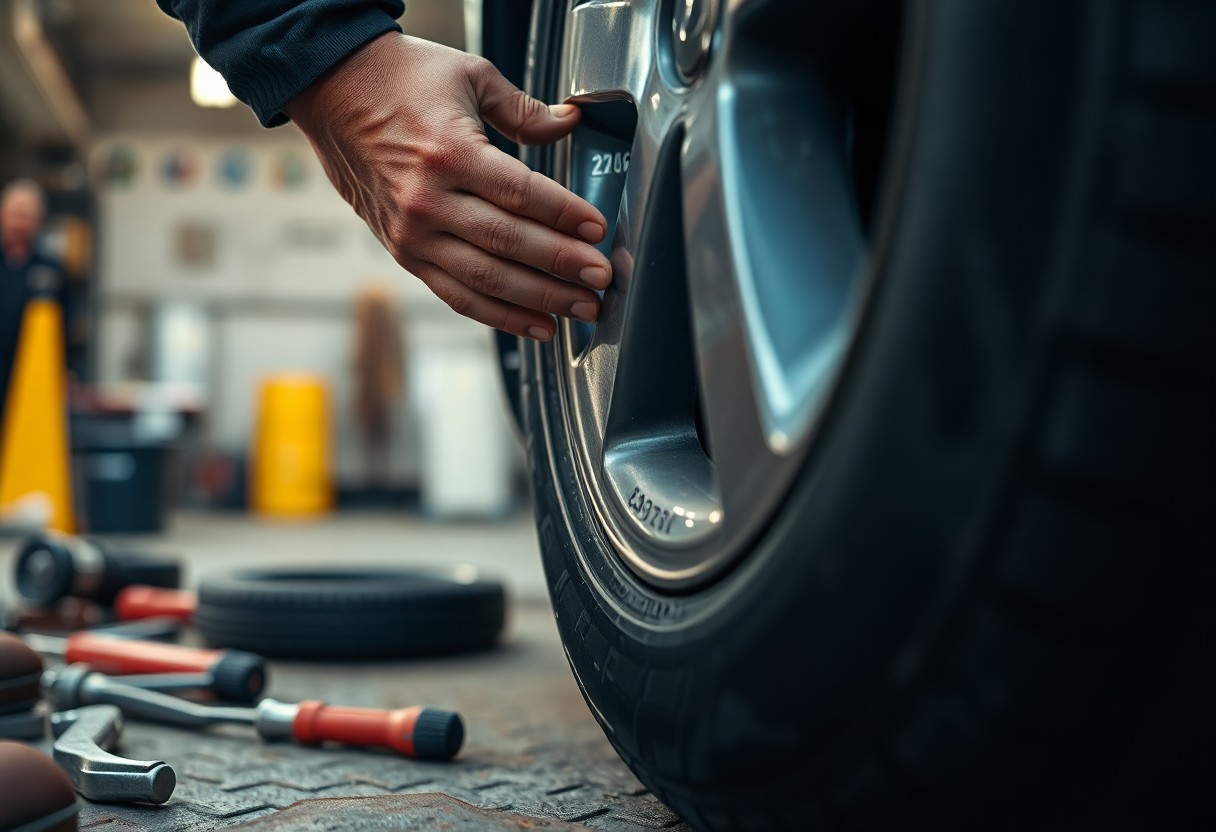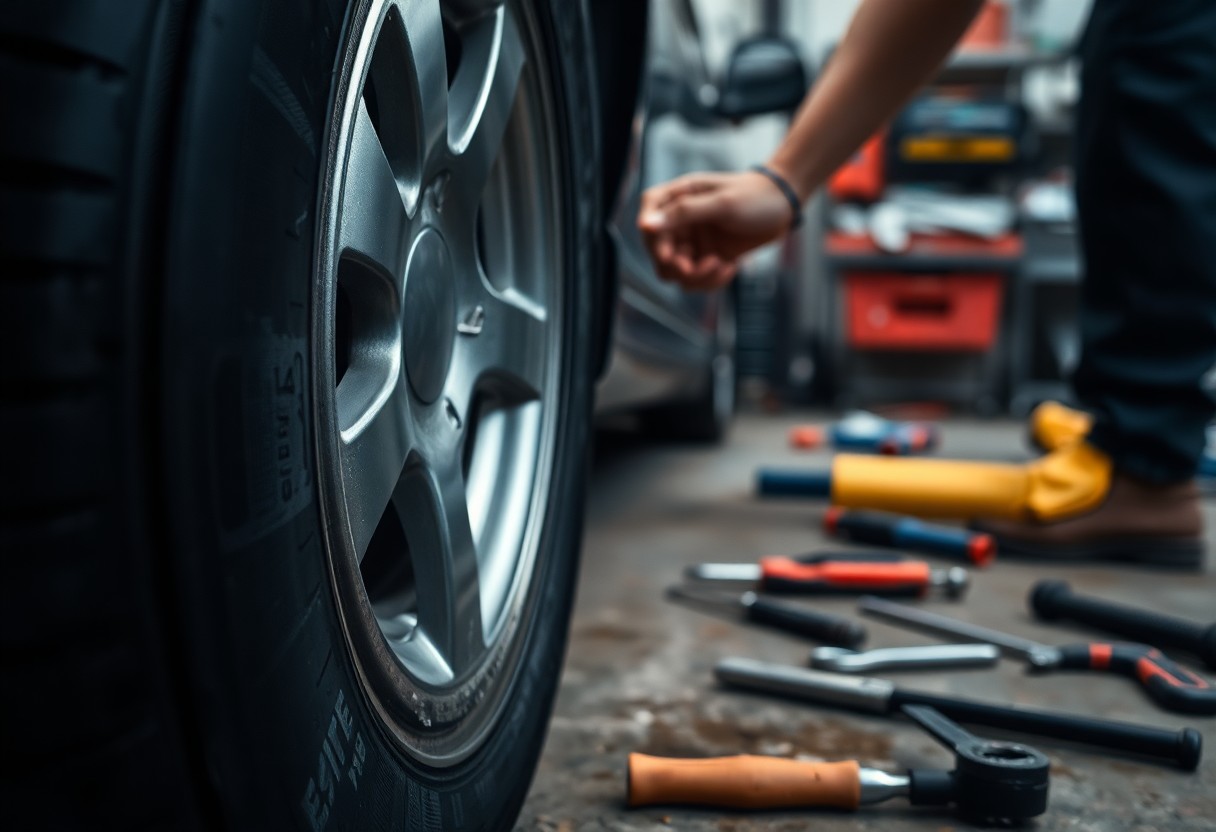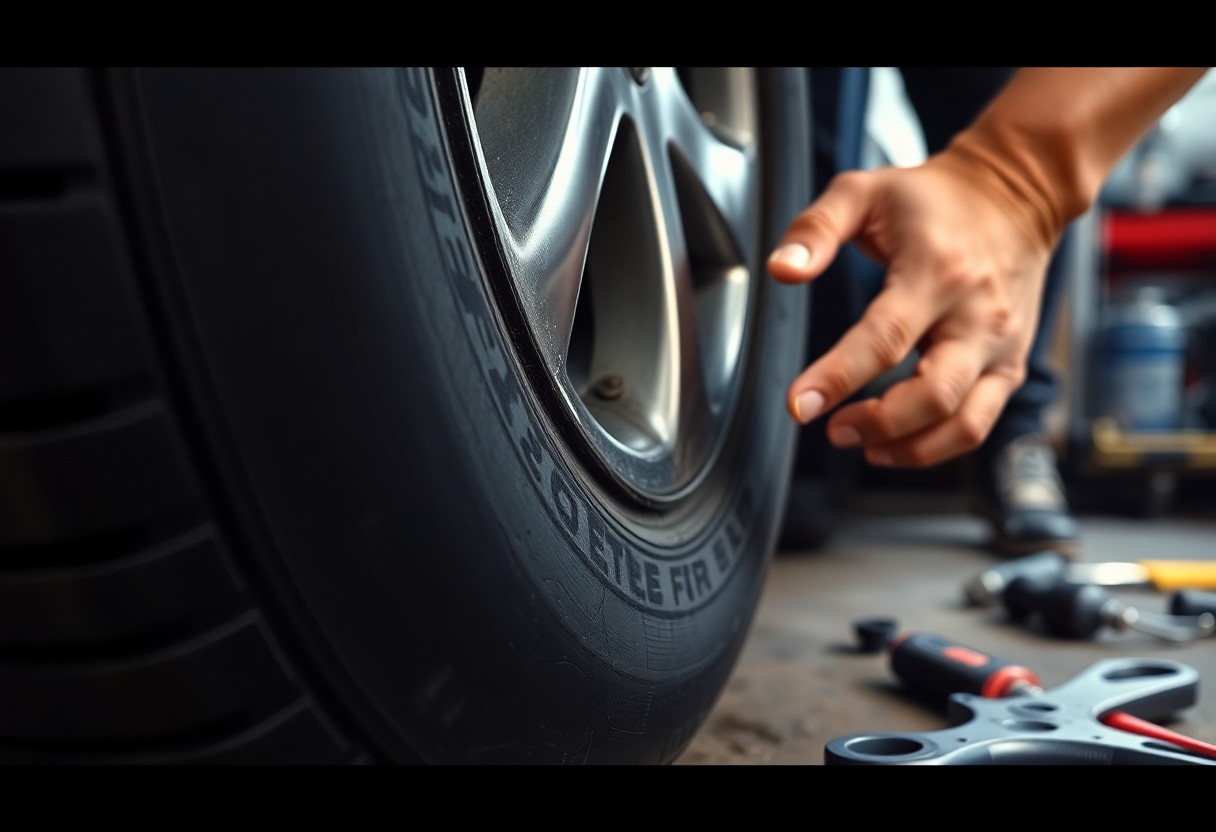Most vehicle owners often overlook the importance of checking your tyre expiry date, which can directly impact your safety on the road. Understanding when your tyres need replacing is vital for maintaining optimal performance and preventing accidents. In this guide, you will learn how to easily determine the age of your tyres, ensuring that you make informed decisions to keep your travels safe and worry-free. Let’s explore the steps you need to follow to assess the condition of your tyres.

Key Takeaways:
- Tyres have a shelf life, typically around 6-10 years, depending on the manufacturer and tyre type.
- The expiry date is indicated by the DOT code found on the sidewall of the tyre, which includes the week and year of manufacture.
- It’s important to check for signs of wear and damage, as age can affect tyre performance and safety, even if the tread appears fine.
- Generally, tyres should be replaced every 5-6 years, but specific guidelines may vary based on usage and environmental conditions.
- Consulting a professional mechanic for thorough inspections can help in assessing whether tyres should be replaced.
- Storage conditions can impact tyre longevity; keeping them in a cool, dry place can help extend their life.
- Regular maintenance and checking tyre pressure can enhance performance and safety, regardless of age.

Decoding the Manufacturing Date on Your Tyres
Understanding how to decode the manufacturing date on your tyres empowers you to assess their viability and safety. Tyres come with a code that indicates when they were produced, which plays a key role in determining their lifespan and performance. By identifying this vital information, you can ensure you’re driving on tyres that are safe and reliable for your road journeys.
Locate the DOT Code
The DOT code is printed on the sidewall of your tyre and typically consists of a series of numbers and letters. This code begins with ‘DOT,’ followed by a series indicating the manufacturer and plant code, and concludes with a four-digit number that reveals the week and year of manufacture. Finding this code is your first step in checking your tyres’ age.
Interpret the Numbers
The last four digits of the DOT code are critical for understanding your tyre’s manufacturing date. The first two digits indicate the week of production, while the last two specify the year. For example, if your tyre reads ‘2519’, it was manufactured in the 25th week of 2019, meaning it should be monitored closely as it approaches its expiry window.
Interpreting the numbers on your DOT code allows you to make informed decisions regarding your tyres’ safety and performance. Knowing your tyre’s age helps you evaluate whether it still offers adequate grip and stability. If your tyres are over six years old, even if they appear visually sound, it may be time to consider replacements to avoid the risks of tread separation or blowouts while driving. Ensuring that your tyres are within the acceptable age range can significantly enhance your vehicle’s performance and your safety on the road.
Understanding Tyre Lifespan: What You Need to Know
The lifespan of a tyre isn’t just determined by its age but also influenced by various factors. Regularly checking your tyres is necessary to ensure safety while driving. Most tyres have a lifespan of about 6-10 years, but your driving habits, road conditions, and maintenance practices can all impact how long they last.
Factors Affecting Tyre Expiry
Several aspects contribute to the expiry of your tyres, which include:
- Driving habits – Aggressive driving can lead to prematurely worn tyres.
- Road conditions – Rough or uneven surfaces can accelerate wear.
- Maintenance – Regular rotation, alignment, and balancing will enhance durability.
- Climate – Extreme temperatures can degrade rubber compounds.
After considering these factors, you can better manage your tyres’ health and safety throughout their lifespan.
Common Myths About Tyre Aging
Misconceptions surround tyre aging, leading to unsafe choices for some drivers. One prevalent myth suggests that new tyres will last longer than older ones irrespective of condition. In reality, the rubber compounds can deteriorate over time even if the tread appears fine. Another belief is that only tread depth affects tyre performance, ignoring that age and environmental exposure are equally critical.
Many believe that as long as a tyre’s tread appears intact, it remains safe. However, the reality is that rubber degrades naturally due to factors like exposure to sunlight, ozone, and extreme temperatures. Age significantly impacts the structural integrity of the tyre, leading to potential blowouts or poor traction. Tyres over 5 years old should be closely monitored for signs of damage, while those over 10 years are generally recommended for replacement regardless of tread depth. Always prioritize both tread condition and age to ensure your safety on the road.
Evaluating Tyre Condition Beyond Expiry Dates
Expiry dates are just one aspect of determining your tyre’s health. Regular evaluation involves inspecting the overall condition of the tyres, which includes assessing for any signs of wear, damage, and suitability for safe vehicle operation. Keeping an eye on these factors can significantly enhance your driving safety and prolong the life of your tyres.
Visual Inspections: Tread Wear and Defects
Conducting visual checks is important for maintaining tyre safety. Look for signs of uneven tread wear, which could indicate alignment or suspension issues. Inspect for any cracks, bulges, or foreign objects embedded in the rubber. Tread depth is another critical factor; tyres should ideally maintain a minimum of 1.6 mm to ensure optimal grip and performance.
Professional Assessments: When to Seek Help
Seek professional assistance if you notice any significant damage or if tread wear is uneven. Mechanics equipped with advanced diagnostic tools can provide insights that may not be visible to the naked eye. Regular professional evaluations, ideally once a year, can help preemptively address potential issues that might arise from unnoticed tyre degradation.
Ultimately, consulting with a tyre specialist can uncover hidden problems that require specific attention. They can perform detailed checks like pressure monitoring and inspecting internal structures that you may not be able to assess on your own. This proactive approach not only enhances safety but can also save you money in the long run by preventing more severe and costly repairs related to neglected tyre conditions.

The Importance of Regular Tyre Maintenance
Your tyres are the only point of contact between your vehicle and the road, making their maintenance vital for optimal performance and safety. Regular checks on tread depth, air pressure, and overall condition allow you to identify issues before they escalate. Additionally, maintaining proper alignment and rotation at recommended intervals can extend your tyres’ lifespan, enhance fuel efficiency, and ensure a smoother ride. Prioritizing regular maintenance safeguards your investment and contributes to a better driving experience.
Maintaining Optimal Performance
Proper tyre maintenance directly influences your vehicle’s performance. Keeping your tyres inflated to the recommended pressure enhances handling and maximizes fuel efficiency. Inconsistent pressure can lead to uneven wear, resulting in a shorter lifespan. Routine rotation and alignment checks further support optimal performance by ensuring that your tyres maintain appropriate contact with the road, improving driving dynamics.
Preventing Accidents and Ensuring Safety
Neglecting tyre maintenance can significantly increase the risk of accidents. Under-inflated or worn-out tyres compromise handling and braking distances, making it difficult to control your vehicle in emergency situations. Regular inspections and keeping an eye on tread depth not only boost your safety but also enhance the safety of others on the road. According to the National Highway Traffic Safety Administration, almost 30% of tyre-related accidents are due to low tread depth. Frequent checks help you avoid these hazards.
Staying proactive about your tyre condition means addressing any issue before it leads to potentially dangerous situations. A well-maintained set of tyres improves traction, allowing for better control on wet or slick surfaces, where the risk of hydroplaning skyrockets. Ensuring that your tyres are in optimal condition can save you, your passengers, and pedestrians from tragic accidents that can stem from tyre failures. Think of regular maintenance as an investment in your safety—something that pays dividends every time you hit the road.
Signs That Your Tyres Need Replacement
Identifying the right time to replace your tyres can significantly affect your safety and vehicle performance. Pay attention to several signs that indicate your tyres may be past their prime. These can include uneven tread wear, visible cracks or bulges, and a noticeable decrease in traction during rain or on slick surfaces. Regularly assessing these factors ensures you stay ahead of potential road hazards.
Performance Indicators
Your tyres should perform optimally under various conditions. Diminished handling, increased braking distance, or vibrations while driving often indicate a problem. If you notice these performance issues, it might be time to consider new tyres. Regular maintenance can help mitigate these effects, but deterioration over time is inevitable.
Warning Signals to Watch For
Several warning signals suggest your tyres might need replacing sooner rather than later. Look for tread depth below the recommended 1.6mm, warning lights on your dashboard, or an unusual, loud noise while driving. Consider some of these factors seriously; they can be early indicators of tyre failure or imbalance.
Additionally, if you experience persistent vibrations or steering pulling to one side, these may be signs of damaged tyres or alignment issues. Keeping an ear out for strange noises can also help you detect irregularities caused by internal damage. Always trust your instincts; if your tyres feel off, have them inspected promptly! These warning signals are vital—address them quickly to ensure your safety on the road and avoid costly repairs down the line.
Summing up
On the whole, understanding how to check your tyre expiry date is vital for your safety and vehicle performance. By examining the manufacturing date on the tyre sidewall, typically displayed as a 4-digit code, you can determine the age of your tyres. It’s advisable to replace tyres that are over six years old, even if tread wear looks acceptable. Regular checks will help you ensure your vehicle remains roadworthy and safe. Prioritizing your tyre maintenance will benefit you in the long run, enhancing both your driving experience and safety on the road.
FAQ
Q: How can I find the expiry date on my tyres?
A: To find the expiry date on your tyres, look for the DOT (Department of Transportation) code printed on the tyre’s sidewall. The last four digits of this code indicate the week and year the tyre was manufactured. For instance, if the code ends with “2218,” it means the tyre was made in the 22nd week of 2018.
Q: What does the DOT code mean?
A: The DOT code is a set of numbers and letters that provides important information about the tyre. The first part indicates the manufacturer and the type of tyre, while the last four digits specify the week and year of production. This helps you determine the age of your tyre, which is crucial for maintenance and safety purposes.
Q: How long is the average lifespan of a tyre?
A: The average lifespan of a tyre is typically between 6 to 10 years, depending on various factors such as the type of tyre, driving conditions, and maintenance practices. Regular inspections and appropriate storage can influence how well your tyres perform over time.
Q: What are the signs that indicate my tyres may be expired?
A: Signs that may indicate your tyres are nearing the end of their life include visible cracks in the sidewall, reduced tread depth, uneven wear patterns, or bulges. Additionally, if your tyres are older than six years, it is recommended to have them evaluated by a professional even if they appear to be in good condition.
Q: Can I still use tyres that are past their expiry date?
A: While tyres that are past their expiry date might still appear functional, they may not perform safely. Rubber degrades over time, and expired tyres can be susceptible to blowouts or reduced traction. It is advisable to replace tyres that are over six years old to ensure optimal safety while driving.
Q: How often should I check my tyre conditions?
A: It is wise to inspect your tyres at least once a month and before long trips. During inspections, check for proper inflation, tread depth, and signs of wear or damage. Regular maintenance can significantly enhance the lifespan and performance of your tyres.
Q: What can I do to extend the life of my tyres?
A: To extend the life of your tyres, ensure they are always properly inflated, rotate them regularly according to the vehicle manufacturer’s recommendations, and have them aligned and balanced as needed. Additionally, avoid overloading your vehicle and driving aggressively, as these factors can contribute to premature wear.
